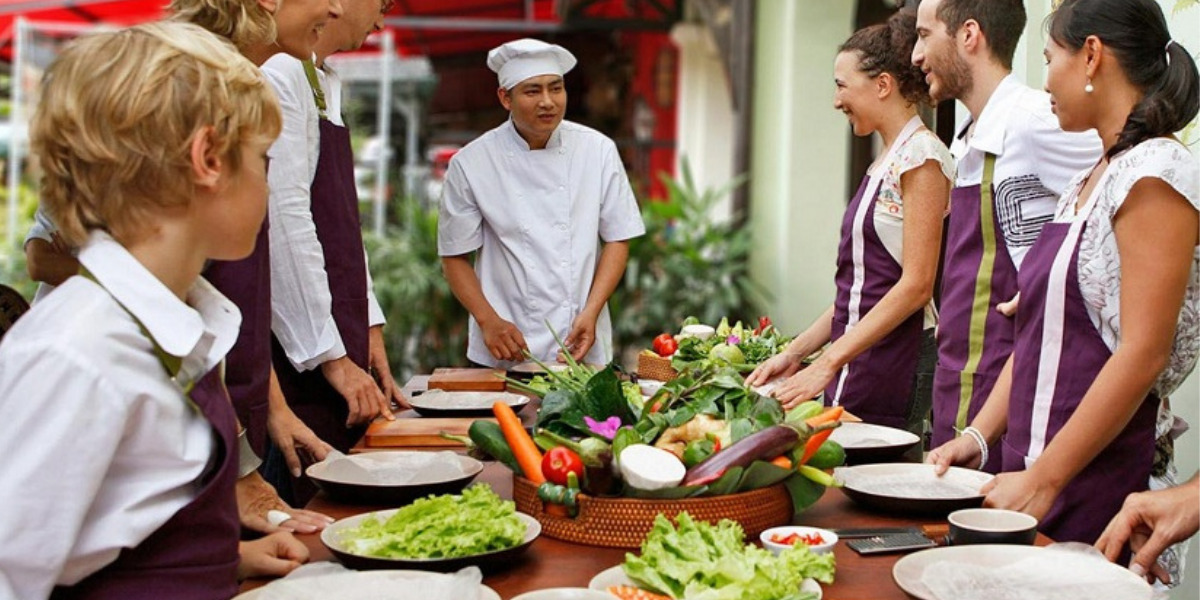As of 2005, Vietnam ranked 16th out of 25 countries with a high level of biodiversity worldwide, home to about 16% of the world's species, including monkeys. Said to be one of the creatures with intelligence close to humans, they have agile, dexterous and flexible movements, feeding on leaves, insects,… Besides biological values, monkeys in Vietnam also have cultural values to Vietnamese, being the expressions of wisdom and health. Check out the article below for more information about types of monkeys, its expression in culture, and top places for tourists to encounter them when traveling to Vietnam.
I - Types of monkeys in Vietnam
Having the geographical advantages, Vietnam possesses a terrain stretching through different climates and forest types, creating various habitats for families of primates. In particular, the Vietnamese monkeys are quite diverse with 5 different species of Macaque monkeys, belonging to the subfamily Cercopithecinae.
1 - Pigtail monkey - one of the most popular monkeys in Vietnam
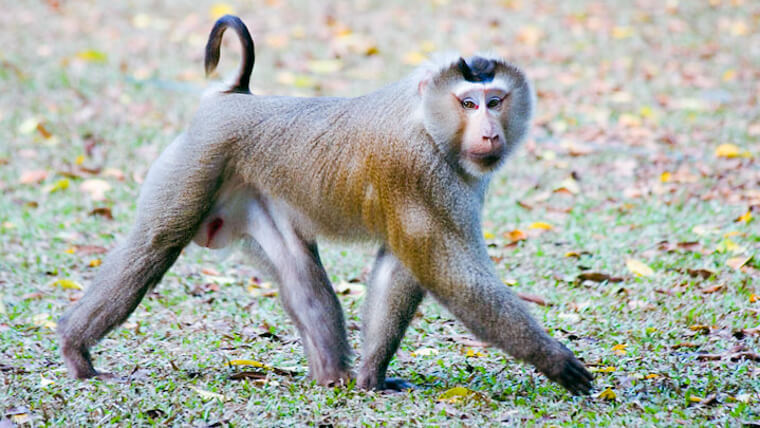
Vietnam pig-tailed monkeys - Source: khoahoc
Scientifically known as Macaca leonina, this monkey species has a body length of 43 - 69.5cm, a tail length of 15 - 23cm, and a weight of about 14kg. They are characterized by a stiff, often fat tail arching upward on the back, resting on the buttocks like a pig's tail. You can also distinguish pig-tailed Vietnamese monkeys by their flattened heads, with dark brown or gray hair forming a “swirl” looking like a cap. Their limbs and face are quite short, covered to the ears by long, dense, light brown hairs. There are red streaks next to their eyes, and a triangular patch of dark brown hair behind their forehead.
Pig-tailed monkeys in Vietnam live in herds consisting of about 15 - 40 individuals (average 15 - 22 individuals), with a ratio of about 5 - 8 females to 1 male. The female lives with her troop from birth, while the male will leave and live alone, or live on the fringes of the herd until he reaches puberty. They reproduce all year round, with a gestation period of about 171 days, giving birth to one litter per year - one child each, reaching maturity after 35 months.
Pig-tailed monkeys are active during the day, occupying all levels of the forest canopy, spending most of their time foraging on the ground, sheltering in rock burrows at night. Pig-tailed monkeys in Vietnam feed on fruit, seeds, leaves, young shoots, bamboo shoots, fungi and some animal prey like insects, live crabs, some nesting birds, and especially sour fruits,…
Distribution area of this species of monkey in Vietnam: Dak Lak, Lao Cai, Lam Dong, Kon Tum, Son La, Ha Giang, Bac Kan, Hoa Binh, Ha Tay, Ha Tinh, Nghe An, Tuyen Quang, Quang Binh, Thua Thien - Hue, Thai Nguyen, Yen Bai, Gia Lai, Tay Ninh, Dong Nai, Ho Chi Minh City.
Danger level: Vulnerable
- World IUCN Red List classified as endangered: VU
- Vietnam Red Book classified as endangered: VU A1c,d
2 - Moldy monkeys (Assamese Macaque)
This monkey species is scientifically known as Macaca Assamensis, having a relatively larger size than other monkeys in Vietnam. Their body length is 41 - 73.5cm and tail length is 14-24.5cm, weighing about 6 - 11kg. They have thick and long fur, the color of which can vary from dark brown to light fawn, but the shoulders, nape, top of the head, and ears are usually lighter and more yellow. In particular, the hair around the face is black and the cheeks are gray, the inner and lower thighs are grayish white. The tail is straight and hairy, relatively short but depending on the individual.
Assamese macaques usually live in small groups of 10 - 50 individuals with a hierarchy of dominance, breeding year-round with one litter each year (one cub). Moldy monkeys in Vietnam are less lively compared to other monkeys, living mainly in the forests on rock mountains, evergreen moist forests, bamboo forests… During the day they are most active, moving on the ground but will eat on trees or in bushes, and climb up tree branches or holes on cliffs to sleep at night. Their food is leaves, flowers, fruits, bamboo shoots, and more, sometimes they also eat insects and vertebrates like lizards.
Distribution: Provinces of Bac Kan, Lao Cai, Ha Giang, Hoa Binh, Ha Tay, Ha Tinh, Nghe An, Son La, Tuyen Quang, Thai Nguyen, Quang Binh, Yen Bai.
Danger level: Vulnerable
- World Red Book IUCN classified as endangered: VU
- Vietnam Red Book classified as endangered: VU A1c,d
3 - Red-faced monkeys in Vietnam (Stump-tailed macaque)
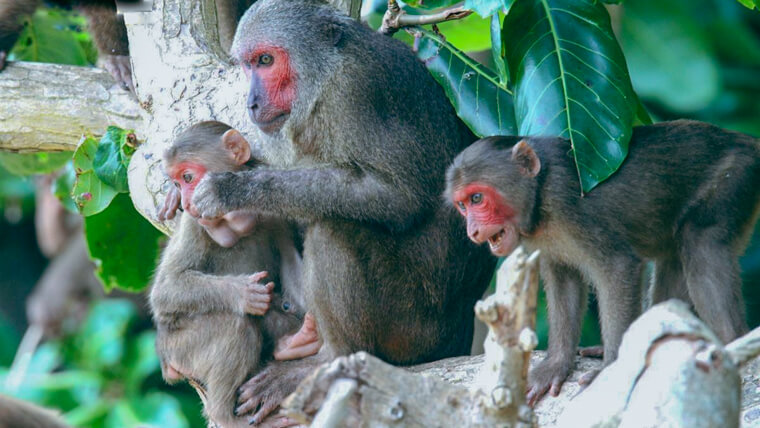
Vietnam red-face monkey - Source: Lê Mạnh Hùng
The red-faced monkey has the scientific name Macaca Arctoides, with a body length of 48.5 - 70 cm, a tail length of 30 - 53 cm, and a weight of about 16 kg. As the name suggests, they have a bright red face that can be browned or blackened by the sun, with the hair on the cheeks radiating back. Their body hair is thick, shaggy with color varying from fawn to dark brown, the back is reddish brown, and the lower part of the abdomen is always lighter than the upper. Stump-tailed macaque also has a large tail but is so short that it is almost absent, and a large rump with no hair.
Red-faced monkeys in Vietnam usually live in groups of 40 - 50 individuals, new males joining must fight to get their place. They breed all year round but only give birth to one litter per year, pregnant for about 170 days. Fierce and daring, this type of Vietnamese monkey is good at climbing and swimming, but mainly active on the ground. They often choose large banyan trees as a place to sleep and jump right off when in panic, howling to warn each other. The food of the red-faced monkey is very diverse, from tubers, cherries, and seeds to some small animals such as worms, salamanders, etc.
Distribution of red-faced monkeys in Vietnam: Provinces of Cao Bang, Dak Lak, Lam Dong, Lai Chau, Lao Cai, Ha Giang, Hoa Binh, Nghe An, Ha Tinh, Quang Binh, Quang Tri, Thua Thien - Hue, Gia Lai, Kon Tum, Thanh Hoa, Tuyen Quang, Son La.
Danger level: Vulnerable
- World Red Book IUCN classified as endangered: VU
- Vietnam Red Book classified as endangered: VU A1c,d & B1+2b,c
4 - Vietnam long-tailed monkey
As the name implies, this monkey can be distinguished from other species by its very long tail, about 50 - 55 cm, with a body weight of 5 - 7 kg. Their fur color can vary with age, usually ranging from light gray to reddish brown with a lighter ventral half, and young born black. The long-tailed monkeys in Vietnam have a pinkish-brown face with a mustache, and the hair on its head is turned to form a tuft of hair on the top of the head like a pointed crest.
This species has the scientific name Macaca fascicularis, with 2 subspecies, the common type - fascicularis (Raffles, 1821) and the Con Dao long-tailed macaque - condorensis (Kloss, 1926). Morphologically, these two subspecies are relatively similar, but the crest on the head of Con Dao Long-tailed Monkey is darker brown. They usually live in herds of 10 - 40 individuals, the lifespan is about 37 - 38 years and it takes 50 - 51 months to reach adulthood. Pregnancy period is from 160 - 170 days, the interval between 2 times of giving birth is 13 months.
Long-tailed monkeys in Vietnam like to live in watery areas such as primary forests, secondary forests, mangroves, island forests, bamboo forests, evergreen forests… Love to bathe underwater, they are good climbers and swimmers, capable of diving for a long time to find food. They mainly live on trees, sleeping in branches that extend to the riverbank so that when there is danger, they can jump into the water and swim until they feel safe. In addition to the main foods such as fruits, seeds, stems, or leaves, long-tailed monkeys also like to catch crabs, shrimps, frogs…
The distribution of this monkey in Vietnam is from Thua Thien - Hue Province to Kien Giang Province.
Danger level: Lower Risk
- World Red Book IUCN classified as less-endangered: LR
- Vietnam Red Book classified as less-endangered: LR
5 - Golden Monkey - one of top common types of monkeys in Vietnam
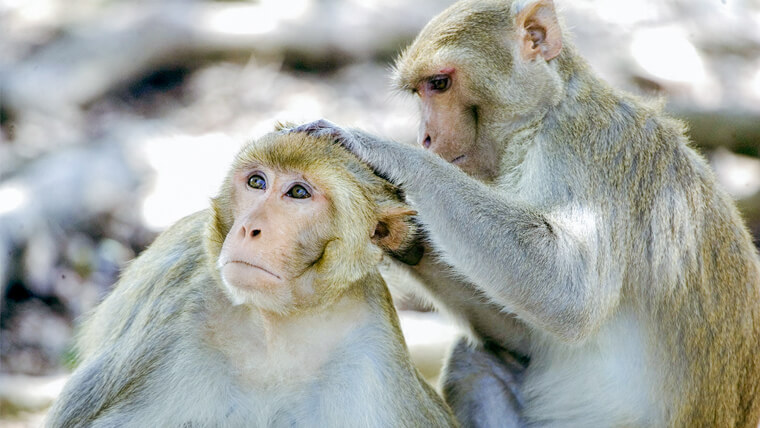
Vietnam golden monkey - Source: vietnamplus
Scientifically known as Macaca mulatta, this is quite a common type of monkey in Vietnam, with a weight of 4- 8kg, a body length of 32 - 62cm, and a tail length of 13 - 23cm. The hair on their body is quite thick and yellow-brown, while the rear half of the body is reddish-brown, and the buttocks and thighs are red-brown. The hair on the top of their head is very short, the face is pink and often hairless, having large cheek pouches to store food when they foraging. Rhesus Macaques are opportunistic omnivores, mainly feeding on roots, fruits, seeds, insects, eggs and small animals.
Golden monkeys in Vietnam live in groups of 8 - 180 individuals, sometimes up to 200, including the number of females usually 2 to 4 times more than males, with the leader being the strongest male. Golden monkeys reach maturity in a period of 42 - 48 months with a lifespan of about 29 years, a gestation period of 164 days, and a 12 - 24 month interval between giving births. Quite fast and noisy, they are often active during the day, on the ground and on tree branches in rocky montane forests along rivers, lakes, or along the coast, in mixed deciduous forests, dipterocarp forests, and so on. These Vietnamese monkeys are distributed from the northern border to the Central Highlands provinces.
Danger level: Lower Risk
- World Red Book IUCN classified as less-endangered: LR
- Vietnam Red Book classified as less-endangered: LR
II - Monkeys in Vietnam culture
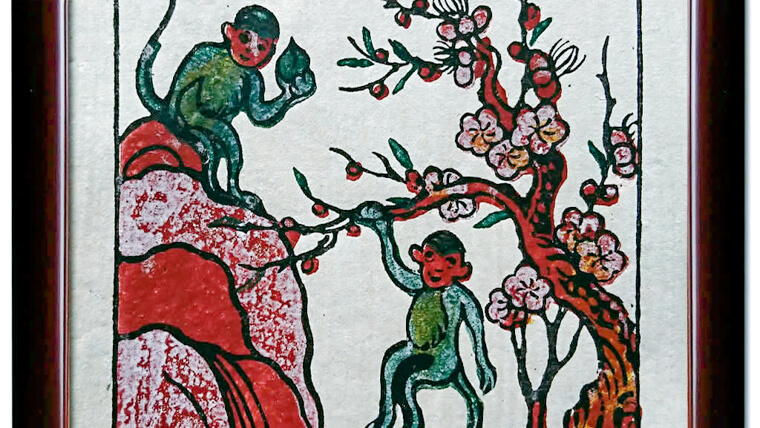
Vietnamese folk painting of monkey - Source: quatangvip
As one of the popular mascots, monkey is the 9th animal in the Decalogue, representing images associated with liveliness, slyness and mischief. People born in the year of the Monkey in Vietnamese concept are usually smart, resourceful and agile, but will face many difficulties, especially women. There are also monkeys who have become symbols to be honored such as Sun Wukong of China, monkey king Hanuman in Indian epics,…
According to some studies, the legend of the Buddha is associated with 5 animals including a monkey - a disciple who is so devoted that they does not mind the danger threatening their life. Monkeys in Vietnam's images also appear in various places, from architectural to art works, showing them holding peaches or catching bees, or expressing maternal love through scenes of a mother monkey holding a baby monkey, etc. Some of the works can be mentioned are the 17th century carvings in But Thap pagoda, stone monkey statues in Chuong Son tower relic from the Ly dynasty. Monkeys have also contributed significantly to the behavioral culture of Vietnamese. Using rhetorical measures, its image is used to form folk songs, proverbs, and poems, expressing attitudes, feelings and behaviors of the creators. Although said to represent intelligence and slyness, the Vietnamese monkey is also often assigned negative connotations. For example, monkey in Vietnamese idioms is sometimes associated with meanness and dishonesty, the middle of nowhere, or sadness and pain.
III - Preservation and conservation tourist sites for monkeys in Vietnam
As a group of animals at high risk of extinction, monkeys currently can only be found in well-protected forests. Here are some places that you can visit and learn about them, where plant and animal species are still guaranteed to be diverse:
1 - Monkey Island Son Tra peninsula - known as Vietnam monkey mountain
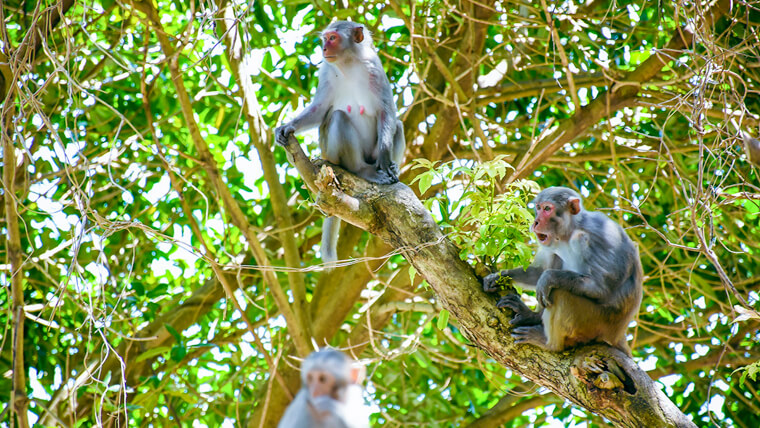
Monkeys in Son Tra peninsula Danang - Source: vietgiaitri
As one of the most impressive and attractive tourist attractions in Da Nang, Son Tra peninsula is also a nature reserve, located in Tho Quang Ward, Son Tra District. This place is inhabited mainly by golden monkeys, which are quite bold and appear a lot in the area behind Linh Ung Pagoda. Golden monkeys in Vietnam have a habit of feeding in the morning and afternoon, so you should go early at 6 - 9am or later at 4 - 6pm to meet them. You can also visit some other tourist attractions here such as Chessboard Peak, the thousand-year banyan tree, the beautiful beaches, etc.
2 - Monkey Island Can Gio forest Vietnam
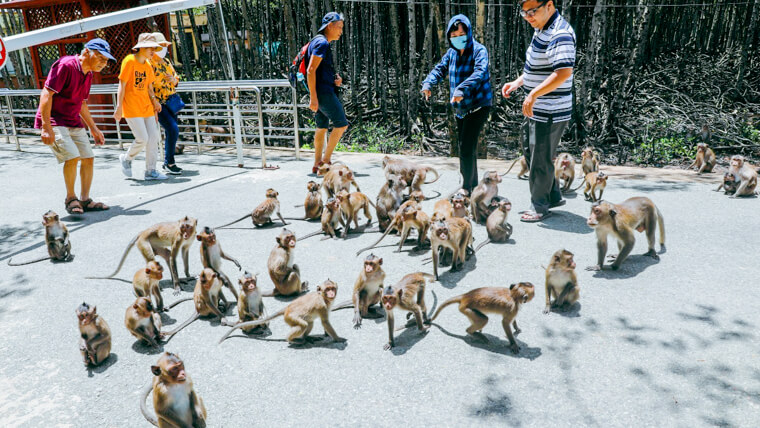
Monkey island in Can Gio mangrove forest - Source: vnexpress
As a famous tourist destination of Can Gio district of Ho Chi Minh City, this is the residence of more than 2000 different Vietnamese monkeys. Here they can live in a wild natural environment, not subject to containment and restrictions as much as zoos in the city. Coming here, you will probably be overwhelmed by countless monkeys in Vietnam swinging branches, passing leaves, jumping around, and sometimes even getting close to you. Besides playing with the adorable monkeys, you can also go sightseeing by boat on the creeks, watch birds in Bat lagoon, participate in crocodile fishing, …
To get to the island you will have to take a ferry for about 5,000 - 10,000 VND / trip ($0.22 - 0.44), and buy an entrance ticket for 35,000 VND / person ($1.53).
3 - Vung Tau Monkey Temple Vietnam
Also known as Truc Lam Chan Nguyen Zen Monastery of Ba Ria - Vung Tau Province, this is a famous tourist site combining spirituality and ecology, the pagoda was spaciously built in 1990 with its back leaning against the cliff and the front facing the East Sea. Coming to the Monkey Temple, you can encounter lots of monkeys in Vietnam, enjoy the peace and quiet space in the middle of mountains and forests, feel the cool breezes from the sea, and so on.
Home to nearly 200 long-tailed macaques, Vung Tau Monkey Temple is also established by the Vietnam Record Organization as “The temple with the most natural monkeys”. They live wild in the mountains, so if you want to meet them, you should come in the morning (8am - 9:30am), or in the afternoon (3pm - 4pm), because this is the time when they eat. You should bring bananas or fruits to feed the monkeys, but remember to go gently and quietly so they won’t get scared.
4 - Cat Ba Monkey Island - top places to see monkeys in Vietnam
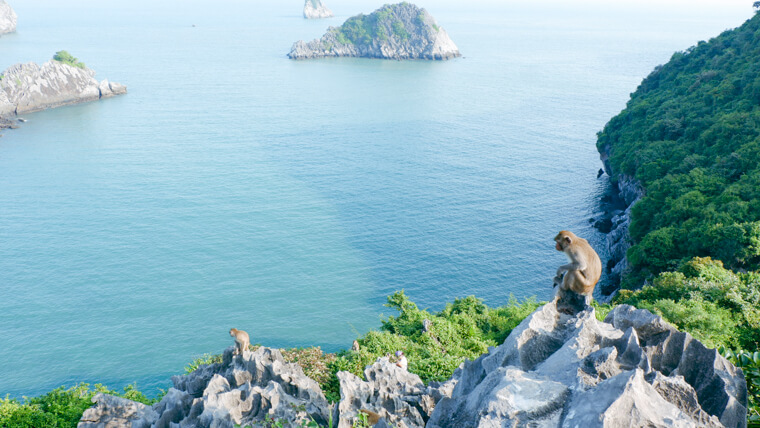
Cat Ba monkey island - Source: @Fernando LG
Among more than 400 islands in Cat Ba archipelago, Monkey Island is prominent with its unique majestic and pristine beauty. This place is also known as Cat Dua Island, which is home to more than 20 smart and extremely friendly yellow-haired monkeys. Visiting the island, you can play and feed them, as well as watch the monkeys do tricks, and swim at the beautiful beaches. There are also other entertainment places nearby that you should not miss such as Cannon Fort, Lan Ha Bay,… The total cost of tickets to visit Cat Ba monkey island is 80,000 VND / person ($3.5), including fees for a boat or ferry.
5 - Nha Trang Monkey Island - Nha Phu Bay
One of the best places to see monkeys in Vietnam is Nha Trang monkey island in Nha Phu bay. Also known as Hon Lao, Monkey Island Nha Trang is a beautiful ecotourism area covering an area of 25ha. The island has a peaceful and picturesque natural landscape with a variety of flora and fauna. In particular, this is home to more than 1200 monkeys, including many different species living in the primeval forests, such as red-faced monkeys, gray-haired monkeys, etc. To go to the island you will have to buy a boat ticket with the price: 180,000 VND / adult ($7.88) and 90,000 VND / child ($3.94).
Visiting Nha Trang monkey island, you will be able to freely see, learn about and play with lovely and very friendly monkeys in Vietnam. It is extremely suitable for animals and nature lovers, families with young children to explore and have fun. In particular, the monkey circus will be an activity that many kids will enjoy, with many attractive performances starting at 3 time frames: 9:30am, 10:30am and 3:15pm. You can also visit Nha Phu Bay, play at the floating park, or participate in many dynamic outdoor sports activities such as ostrich riding, scuba diving, and so on.
Not only contribute to creating a colorful picture for wildlife, but primates also help in the dispersal of flora in the forests where they live. However, despite the abundance of species, primates and especially monkeys in Vietnam are extremely endangered at a global level. That is why many conservation facilities have been established to protect them, giving us the opportunity to see and learn about these animals that are important in Vietnamese culture.







.jpg) — Ha Bich
— Ha Bich





















